|
THIS IS A SIDE PAGE
Return to Main Amida Buddha Page
AMIDA SANZON = AMIDA TRIAD = 阿弥陀三尊
The Triad Format in Japanese Buddhist Statuary
|

Amida Sanzon 阿弥陀三尊
Lit. = Amida Triad
Amida, Seishi, and Kannon
|

Amida Raigō 阿弥陀来迎
Lit. = Amida’s Welcoming Descent
or “Amida Coming in Welcome”
|

Amida Sanzon Raigō 阿弥陀来迎
Lit. = Amida Triad’s Welcoming Descent
or “Amida Triad Coming in Welcome”
|
|
NOTE: In Japanese artwork, the sanzon 三尊 (triad) format was used for Amida as well as for other deities. The term Sanzonbutsu 三尊仏 (three Buddhist deities) is another term that refers to the triad format. The central image is known as the Chūson 中尊, while the attendants on either side are called the Kyōji 脇侍. Some important triads include:
|
|
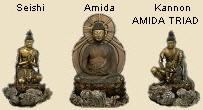 The Amida Sanzon Triad, Amida Raigō, and Amida Sanzon Raigō are common themes in Japanese Buddhist statuary and painting, especially among Japan’s Pure Land (Jōdo 浄土) sects. In triad artwork, Amida Buddha sits in the center and is surrounded by two main attendants (kyōji 脇侍) -- Seishi Bosatsu (representing wisdom) is generally on the right and Kannon Bosatsu (representing compassion) on the left. As Amida faith spread in the late Heian and early Kamakura periods, so too did artwork of Amida descending from heaven to lead the faithful back to his Pure Land of Ultimate Bliss (Jp. = 極楽 Gokuraku; also called Jōdo 浄土). In paintings and scrolls, this is generally depicted by showing Amida riding atop a cloud, often accompanied by Seishi and Kannon. In addition, artwork often depicts Amida surrounded by 25 Bodhisattva (including Seishi and Kannon) descending from heaven to welcome and guide departed souls back to paradise. The term Raigō 来迎 is translated as “coming in welcome.” The Amida Sanzon Triad, Amida Raigō, and Amida Sanzon Raigō are common themes in Japanese Buddhist statuary and painting, especially among Japan’s Pure Land (Jōdo 浄土) sects. In triad artwork, Amida Buddha sits in the center and is surrounded by two main attendants (kyōji 脇侍) -- Seishi Bosatsu (representing wisdom) is generally on the right and Kannon Bosatsu (representing compassion) on the left. As Amida faith spread in the late Heian and early Kamakura periods, so too did artwork of Amida descending from heaven to lead the faithful back to his Pure Land of Ultimate Bliss (Jp. = 極楽 Gokuraku; also called Jōdo 浄土). In paintings and scrolls, this is generally depicted by showing Amida riding atop a cloud, often accompanied by Seishi and Kannon. In addition, artwork often depicts Amida surrounded by 25 Bodhisattva (including Seishi and Kannon) descending from heaven to welcome and guide departed souls back to paradise. The term Raigō 来迎 is translated as “coming in welcome.”
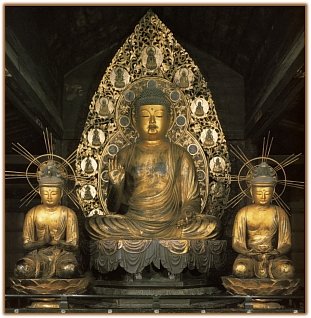
Amida Sanzon Triad 阿弥陀三尊, Wood
Sanzen-in 三千院 (Kyoto). 12th Century (1148 AD). Wood.
H = 233 cm (central image). Shippaku 漆箔 method of affixing gold to the lacquered statues.
Photo courtesy magazine 日本の美をめぐる, No. 45, Published by Shogakugan 2003.
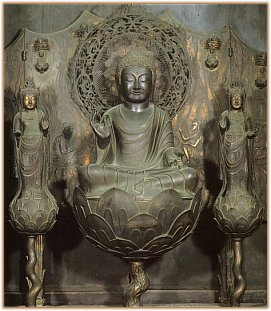
Amida Sanzon Triad 阿弥陀三尊, Bronze
8th Century AD, H = 33.3 cm (central statue)
Hōryūji Temple 法隆寺

Amida Sanzon Raigou 阿弥陀三尊来迎
Below text courtesy JAANUS
Painted images of Buddhas (Jp = Nyorai) and Bodhisattvas (Jp = Bosatsu), such as Shaka 釈迦, Yakushi 薬師, Miroku 弥勒, Kannon 観音, and Jizou 地蔵, but most notably Amida 阿弥陀 and his attendants, "coming in welcome (raigou 来迎)" to the Western Paradise. Where Amida is depicted, the image is often called Amida Raigou-zu 阿弥陀来迎図. Followers of Pure Land Buddhism (Jouudokyou 浄土教) believe that upon death Amida and his retinue will descend from his Western Pure Land (saihou gokuraku joudo 西方極楽浄土) to earth to welcome and escort the devotee back to Amida’s Paradise. The doctrinal basis for this belief is to be found in the nineteenth of Amida's 48 vows enumerated in the MURYOUJUKYOU 無量寿経 (the Larger Sukhavatiyuha Sutra, or "Sutra of Infinite Life"). Amida, often flanked by Kannon and Seishi 勢至 (an image known as Amida Sanzon Raigou 阿弥陀三尊来迎) and frequently accompanied by the rest of his heavenly retinue of bodhisattvas and heavenly beings (Amida shoujuu raigou 阿弥陀聖衆来迎), or sometimes limited to 25 Bodhisattvas (known as Amida Nijuugo Bosatsu Raigou 阿弥陀二十五菩薩来迎), is usually shown in painting as descending towards earth on a cloud that trails off on a diagonal. The emphatic jin'un no Amida 迅雲阿弥陀 (swift cloud Amida) or haya-raigou 早来迎 (fast raigou) type shows Amida hastily descending at an angle of 45 degrees, lending a degree of inevitability and immediacy to Amida's promised salvation . In the rapid descents Amida often stands and is turned three-quarters to the side, but in the more gentle descents, he may be seated displaying the raigou-in 来迎印 mudra and facing forward. A variant pose shows Amida and his attendants turned completely around and heading back to his Pure Land Paradise. This is called the kaeri raigou 帰り来迎, or "returning raigou."
|

See Raigozu Painting at this
Kyoto National Museum page.
Amida Coming over the Mountain
Hanging Scroll, Color on Silk, Kamakura Era
See Amida & 25 Attendants at this
Kyoto National Museum page.
Hanging Scroll, Color on Silk, Kamakura Era
Treasure of Chion-in Temple, Kyoto
|
|
The earliest raigou theme in Japan appears to have been the paintings of the kubon raigou 九品来迎 (also known as kubon oujou 九品往生), or the "Nine Levels of Birth," depicted in the bottom outside court of the Taima mandara 当麻曼荼羅, also known as a Kangyou hensou 観経変相 (Transformation Scene of the KANMURYOUJUKYOU 観無量寿経 Sutra) and dating back to the late 8th century. Independent kubon raigou themes appeared on the wooden doors and panels of Amida halls (Amidadou 阿弥陀堂) in the early Heian period. The earliest extant example is in the Phoenix Hall (Hououdou 鳳凰堂), Byoudouin 平等院, dated to 1053. Also instrumental in the development of individual raigou paintings was the Tendai 天台 monk Genshin 源信 (942-1017), whose OUJOUYOUSHUU 往生要集 (Essentials of Salvation) served as a guide for the Amidist faithful, helping them in their final moments to ensure their rebirth in Amida's Pure Land. Genshin's vivid descriptions of the glories of Amida and his Pure Land inspired the creation of a different lineage of raigou paintings and a set of practices for the faithful as they approached death. For example, in terminal practice (rrokuji myougou 六字名号), the dying believer would chant the nenbutsu 念仏 (supplication to Amida), lie on his/her bed, place his/her head to the north and face west, where one or more sculptures of Amida or an Amida raigou painting would be strategically placed in his/her line of vision. A five colored cord, like that attached to the painting of the Yamagoe no Amida 山越阿弥陀 (Amida Coming Over the Mountain) at the Konkaikoumyouji Temple 金戒光明寺 in Kyoto, would then be attached to the image or painting at one end and held by the devotee at the other, thereby establishing a physical link between the two at the moment of death. <end quote from JAANUS>

Yamagoe no Amida 山越阿弥陀. Text Courtesy JAANUS
Also read Yamagoshi no Amida. Also Amida Yamagoe/Yamagoshi Raigō 阿弥陀山越来迎. Literally Amida Coming Over the Mountain. A variant of the raigō painting (raigōzu 来迎図), with Amida, either seated or standing, shown rising above or coming through a mountain landscape in the foreground with various attendants accompanying him.
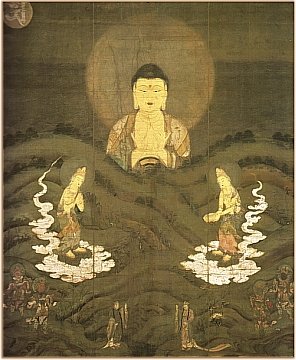
山越阿弥陀図 - Yamagoe Amida
Decent of Amida Over the Mountain.
Hanging Scroll. Color on Silk. National Treasure of Japan.
Kamakura Era, Treasure of Zenrin-ji Temple (Kyoto).
Photo Courtesy Zenrin-ji Temple (also called Eikando)
永観堂 禅林寺, 一躯像高 77cm, 平安後期~鎌倉初期
Amida's mudra in such artwork is often (but not always) the Tenbōrin-in 転法輪印 (the preaching mudra), with both hands turned outward and thumb and forefinger forming circles before the chest. This mudra (hand gesture) is associated with the upper grade: middle birth (jōbon chūshō 上品中生) of the Amida Kubon-in 阿弥陀九品印 (representing the nine levels of rebirth in Amida’s Pure Land). Learn more about the Nine Mudra of Amida here. The Yamagoe Amida paintings were displayed during the Nembutsu 念仏 practice for a dying person. A fragment of the five-colored strings, which are thought to once connect a dying believer with the deity, remain on Amida's hand. An example of this is the 14-century painting at Konkaikōmyōji Temple 金戒光明寺 in Kyoto. The origin of the Yamagoe Amida iconography is not clear. Legend says that it is derived from a vision of the Tendai 天台 monk Genshin 源信 (942-1017). <end JAANUS text>

Mikaeri Amida 見返り阿弥陀 (Amida Looking Back)
The famous Mikaeri Amida, a statue showing Amida looking back, is located at Zenrin-ji Temple 禅林寺 (Kyoto). See photos below. For more on Zenrin-ji, also known as Eikando, please click here (outside link). For a list of the temple’s treasures, click here (outside link). One of the chief priests of this temple was Yokan (1033-1111), who is commonly known as Eikan 永観. According to legends from the temple, on the early morning of 15 Feb. 1082, Eikan was conducting "Nembutsu" chants to Amida Buddha while walking around the altar. When the Amida statue stepped down from the altar and began to lead Eikan to salvation, the monk became stunned and stopped walking. This prompted Amida to look back over the left shoulder and proclaim "Eikan, you are slow." Eikan then awoke from his dream, deeply impressed by the merciful head-turned pose of Amida. He pleaded with the deity to keep the pose forever. Since then, this Amida statue has been known as the "Mikaeri Amida (Amida Looking Back)." This pose symbolizes Amida's mercy and patience in waiting for those who are late in gaining faith. <Story from the temple’s website>
 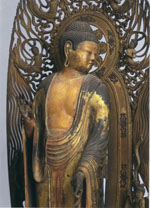 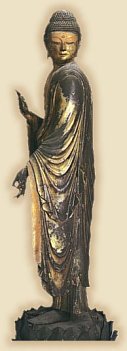
Mikaeri Amida 見返り阿弥陀 (Amida Looking Back)
Zenrin-ji Temple 禅林寺 (Kyoto)
77 cm in height, Late Heian to Early Kamakura Period

LEARN MORE
- JAANUS database. There are many sub-links to numerous Amida-related topics. Also see the JAANUS entry on Sanzonbutsu三尊仏.
- Kyoto National Museum. Provides photos and descriptions of various Amida Triads.

THIS IS A SIDE PAGE
Click here to return to Main Amida Nyorai Page
|